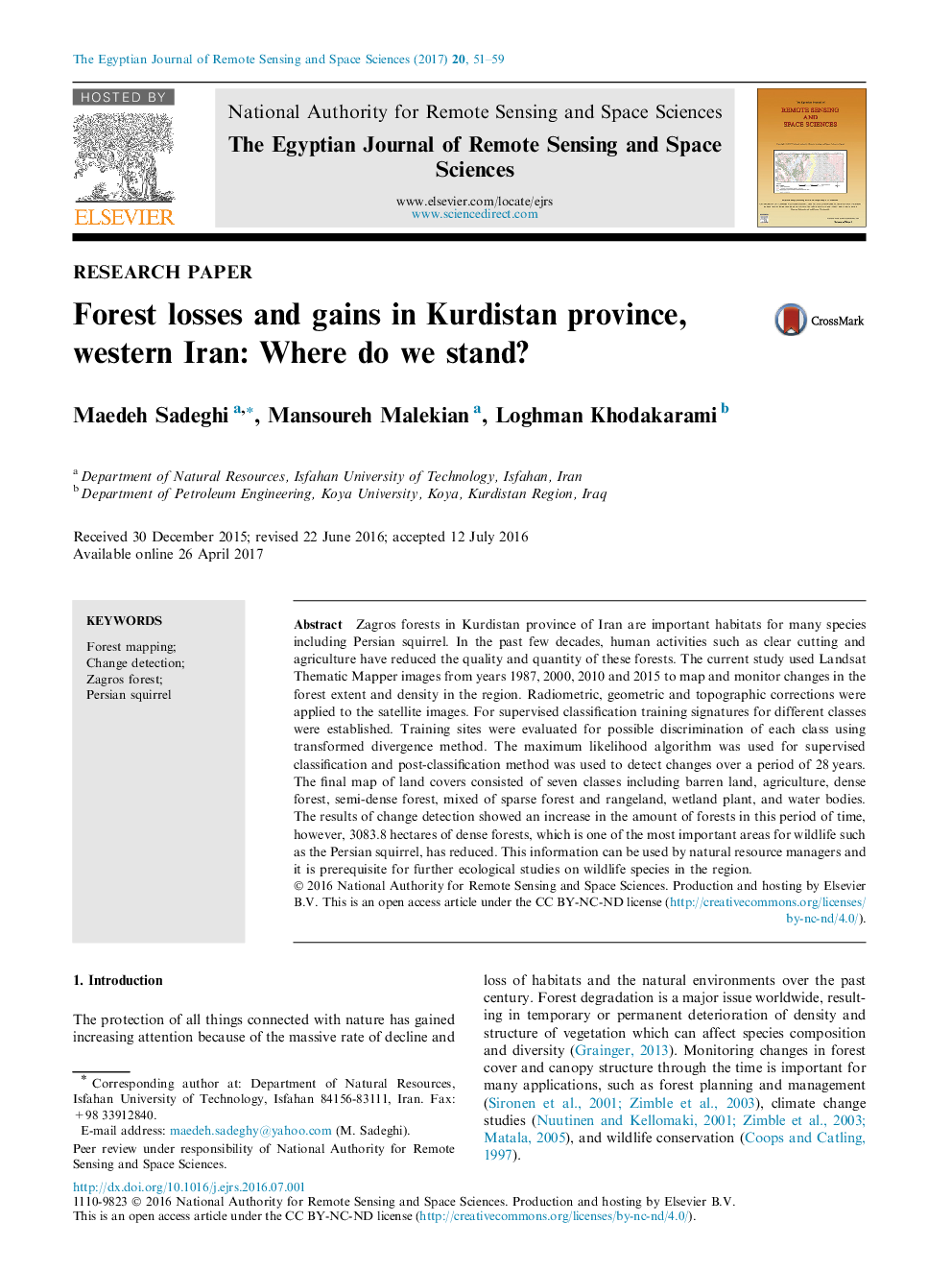| کد مقاله | کد نشریه | سال انتشار | مقاله انگلیسی | نسخه تمام متن |
|---|---|---|---|---|
| 5780170 | 1635089 | 2017 | 9 صفحه PDF | دانلود رایگان |
عنوان انگلیسی مقاله ISI
Forest losses and gains in Kurdistan province, western Iran: Where do we stand?
ترجمه فارسی عنوان
ضرر و زیان جنگل ها در استان کردستان غرب ایران: کجا ما ایستاده ایم؟
دانلود مقاله + سفارش ترجمه
دانلود مقاله ISI انگلیسی
رایگان برای ایرانیان
کلمات کلیدی
نقشه برداری جنگل، تشخیص تغییر، جنگل زاگرس، سنجاب ایرانی،
ترجمه چکیده
جنگل های زاگرس در استان کردستان زیستگاه های مهمی برای گونه های بسیاری از جمله سنجاب ایرانی هستند. در چند دهه گذشته، فعالیت های انسانی مانند برداشت و کشاورزی، کیفیت و کمیت این گونه جنگل ها را کاهش داده است. در این مطالعه از سال 1987، 2000، 2010 و 2015 تصاویر نقشه برداری زمستانی لندست برای نقشه گیری و نظارت بر تغییرات در میزان و تراکم جنگل در منطقه استفاده شده است. تصحیحات رادیومتریک، هندسی و توپوگرافی به تصاویر ماهواره ای اعمال شد. برای طبقه بندی تحت نظارت امضاهای آموزشی برای کلاس های مختلف ایجاد شد. سایت های آموزشی برای تبعیض احتمالی هر کلاس با استفاده از روش واگرایی تبدیل شده مورد ارزیابی قرار گرفتند. الگوریتم حداکثر احتمال برای طبقه بندی تحت نظارت استفاده شد و از روش پس از طبقه بندی برای تشخیص تغییرات در یک دوره 28 ساله استفاده شد. نقشه نهایی پوشش های زمینی شامل هفت طبقه شامل زمین های بی ادعا، کشاورزی، جنگل های متراکم، جنگل های نیمه متراکم، مخلوط جنگل و مرتعی کم، گیاه تالاب و آبهای سطحی بود. نتایج حاصل از تغییرات نشان می دهد افزایش میزان جنگل ها در این دوره زمانی، با این حال، حدود 3083.8 هکتار جنگل های متراکم که یکی از مهم ترین مناطق حیات وحش، مانند سنجاب ایرانی است، کاهش یافته است. این اطلاعات می تواند توسط مدیران منابع طبیعی مورد استفاده قرار گیرد و پیش نیاز مطالعات اکولوژیکی بیشتر در مورد گونه های حیات وحش در منطقه است.
موضوعات مرتبط
مهندسی و علوم پایه
علوم زمین و سیارات
علوم زمین و سیاره ای (عمومی)
چکیده انگلیسی
Zagros forests in Kurdistan province of Iran are important habitats for many species including Persian squirrel. In the past few decades, human activities such as clear cutting and agriculture have reduced the quality and quantity of these forests. The current study used Landsat Thematic Mapper images from years 1987, 2000, 2010 and 2015 to map and monitor changes in the forest extent and density in the region. Radiometric, geometric and topographic corrections were applied to the satellite images. For supervised classification training signatures for different classes were established. Training sites were evaluated for possible discrimination of each class using transformed divergence method. The maximum likelihood algorithm was used for supervised classification and post-classification method was used to detect changes over a period of 28Â years. The final map of land covers consisted of seven classes including barren land, agriculture, dense forest, semi-dense forest, mixed of sparse forest and rangeland, wetland plant, and water bodies. The results of change detection showed an increase in the amount of forests in this period of time, however, 3083.8Â hectares of dense forests, which is one of the most important areas for wildlife such as the Persian squirrel, has reduced. This information can be used by natural resource managers and it is prerequisite for further ecological studies on wildlife species in the region.
ناشر
Database: Elsevier - ScienceDirect (ساینس دایرکت)
Journal: The Egyptian Journal of Remote Sensing and Space Science - Volume 20, Issue 1, June 2017, Pages 51-59
Journal: The Egyptian Journal of Remote Sensing and Space Science - Volume 20, Issue 1, June 2017, Pages 51-59
نویسندگان
Maedeh Sadeghi, Mansoureh Malekian, Loghman Khodakarami,
